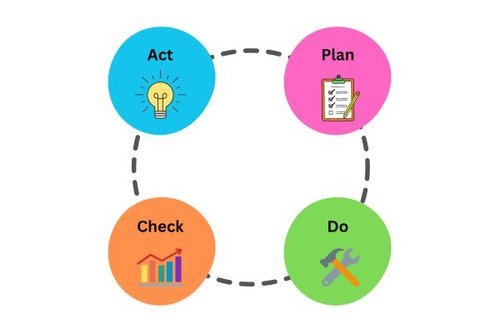What Is ITIL?- A Beginner's Guide To IT Infrastructure Library
In the last edition of our series on IT Service Management (ITSM), we introduced the popular ITSM frameworks including ITIL, COBIT, ISO 20000, and Scrum. In this blog post, we will dive deeper into the most commonly used framework, ITIL.
Let’s jump right into the topic…
What Is ITIL?
ITIL (Information Technology Infrastructure Library) is the most common ITSM framework. It, essentially, is a set of guidelines and IT best practices designed to help organizations to align their IT services with business needs and customer expectations.
ITIL covers the selection, planning, delivery, and maintenance of IT services, with the goal of delivering exceptional services, efficiency, and satisfaction, helping organizations optimize their operations and enhance business value.
Over the years, the role of technology in business has grown immensely and with this growth, the role of the IT department has taken greater significance. It is widely accepted that the IT department is not a cost center but a driver of business value. But this realization did not appear overnight.
In the early days of enterprise IT, most organizations suffered due to a lack of formal processes for requesting services or reporting IT incidents. There was poor communication between IT and other departments because of which collaboration suffered and IT was unable to effectively serve the needs and goals of the business.
But as enterprise IT matured, there was a growing realization of the need to demonstrate its role in driving business value by catering to the specific needs that contribute to achieving business goals and objectives. This led to the practice of IT in a new paradigm known as IT Service Management (ITSM). At the core of ITSM is treating IT as the service provider and the business as the customer.
Therefore, to truly deliver value to the customer, i.e., the business, IT had to provide services that aligned with the strategic requirements of the business. As more organizations developed their IT capabilities under the new ITSM paradigm, it became necessary to establish standardized processes for the management of IT services. This gave rise to the development of several ITSM frameworks, the most prominent among them being the ITIL framework.
Brief History Of ITIL
ITIL was originally developed by a UK Government agency, the Central Computer and Telecommunications Agency (CCTA) with the goal of standardizing IT management practices across government functions. In 1988, the CCTA published its first set of guidelines called the Government Infrastructure Management Method (GITMM). However, in 1989, the GITMM was rebranded to what we now know as the Information Technology Infrastructure Library (ITIL).
ITIL V1
The first version of ITIL comprised a massive 40 separate volumes. Although it was quite unrefined compared to later versions, it did cover the major processes involved in service support including service level management, help desk management, change management, and software distribution and control. Additionally, it also covered contingency planning, problem management, configuration management, and cost management.
Despite the rudimentary organization of ITIL v1, the standard continued to grow in popularity and additional publications were released throughout the 1990s. This can largely be attributed to its relevance to service management, which is true even today.
ITIL V2
The second version of ITIL, i.e., ITIL v2 was published in 2001. This revision was necessitated by two main reasons. First, since the late 1990s, there was a growing competition in ITSM frameworks with the emergence of new standards such as COBIT, ISO 20000, etc. Second, the first version of ITIL had a number of inconsistencies and duplicate entries that needed to be addressed.
Therefore, to stay relevant ITIL v2 was released. In addition to addressing the issues with its previous version, ITIL v2 also included new IT concepts. It improved and reorganized the processes into a more structured framework. ITIL v2 discussed topics including release management, incident management, financial management of IT assets, security management, and service continuity management.
Since its release in 2001, additional publications were added to make it more robust, clarify terminology, and, importantly, provide additional guidance for small businesses.ITIL v2 served as an important intermediate step between v1 and v3, which was an even more comprehensive standard.
ITIL V3
The third version of ITIL, which was released in 2007, further refined and organized the ITIL framework. The ITIL v3 consisted of the following five parts:
ITIL Service Strategy
ITIL Service Design
ITIL Service Transition
ITIL Service Operation
ITIL Continual Service Improvement
ITIL v3 set out a comprehensive set of processes and functions covering the various aspects that support the delivery of IT service. It covered the entire lifecycle of service including processes for prioritizing the delivery of services that meet the business needs to continual service improvement.
ITIL V4
The most recent version, which was released in 2019, is defining a new paradigm in IT service management by promoting a holistic approach to service management. This new model identifies key factors as critical to successful service delivery. These include:
Organizations and people
Information and technology
Partners and suppliers
Value streams and processes
What’s new about this approach is that unlike the previous versions, which focused on IT service management throughout the service lifecycle, ITIL v4 focuses on an entirely new model, the Service Value System (SVS). The SVS takes a holistic view of how IT services can create business value for the customer, i.e. the organization.
What Are The Benefits Of ITIL?
Implementing the ITIL framework brings extensive benefits impacting not just IT service management but also the business as a whole. The key benefits are summarized below:
1. Improved Service Quality
ITIL provides a structured approach to IT service delivery that is customer-centric. This ensures that the services are consistent, reliable, and aligned with business needs, leading to improved service quality.
2. Better Customer Satisfaction
ITIL framework’s focus on understanding and meeting customer needs helps organizations provide services tailored to customer needs, leading to enhanced customer satisfaction.
3. Efficient Service Delivery
ITIL emphasizes efficient processes and streamlined workflows, reducing unnecessary delays and bottlenecks in service delivery. This results in quicker response times and better resource utilization.
4. Clearer Communication
ITIL promotes effective communication between IT teams and other departments within the organization. This reduces misunderstandings, improves collaboration, and ensures that everyone is on the same page regarding service expectations.
5. Reduced Service Disruptions
The incident and problem management processes of ITIL enable organizations to identify and resolve issues more effectively, minimizing service disruptions and their impact on the business.
6. Cost Savings
The ITIL framework can help organizations identify and eliminate waste in areas such as resource utilization, process efficiency, and incident management.
7. Risk Management
ITIL incorporates risk management principles that help organizations identify and mitigate risks associated with IT service delivery, ensuring business continuity.
8. Change Management
ITIL's robust change management processes help to minimize the risk of service disruptions caused by changes by ensuring that changes to IT services are properly planned, tested, and implemented.
9. Continuous Improvement
ITIL encourages a culture of continuous improvement through regular assessments, reviews, and refinements of ITSM processes leading to continuous enhancement of service quality.
10. Improved Credibility
ITIL is a globally recognized framework that enhances the organization's credibility and reputation.
11. Adaptability
The ITIL framework is designed to be adaptable to emerging technologies. It provides a solid foundation but is flexible enough to allow the integration of new technologies and methodologies into existing ITSM practices.
What Is The ITIL Process?
The ITIL process consists of a set of processes organized into five core phases, also known as the ITIL lifecycle. Each phase represents a stage in the management of IT services. The ITIL process is iterative and each stage can be repeated as needed.
Here’s a quick overview of the ITIL process phases:
1. Service Strategy
The service strategy phase of ITIL is focused on aligning IT services with business objectives and understanding customer needs. The key processes included in this phase are:
Service Portfolio Management: This process involves defining, analyzing, and managing the services offered or planned to be offered.
Financial Management for IT Services: This process is concerned with managing the costs associated with providing IT services and ensuring value for money.
Demand Management: This involves forecasting and managing customer demand for services.
2. Service Design
The service design phase is focused on designing services based on the requirements defined in the service strategy phase. The key processes included in this phase are:
Service Catalog Management: This process involves creating and maintaining a catalog of services that are available for customers.
Service Level Management: This process is concerned with defining service levels, agreeing upon them with customers, and ensuring the service levels are met.
Availability Management: This process is focused on ensuring that IT services are available when needed by the business.
Capacity Management: This involves managing IT resources to ensure that the capacity matches business demands.
3. Service Transition
The service transition phase of ITIL focuses on the implementation of new or changed services. The key processes in this phase include:
Change Management: This involves evaluating, planning, and implementing changes to IT services in a controlled manner.
Release and Deployment Management: This process is concerned with managing the rollout of new or updated services and features.
Service Validation and Testing: This focuses on ensuring that new or modified services meet quality and performance expectations.
4. Service Operation
The service operation phase is concerned with the day-to-day management of IT services. The key processes in this phase include:
Incident Management: This process is concerned with restoring normal service operation, following incidents, as quickly as possible.
Problem Management: This process involves identifying and addressing the root causes of recurring incidents.
Event Management: This involves monitoring and managing events that can potentially impact IT services.
Request Fulfillment: This is concerned with fulfilling the service requests raised by customers.
5. Continual Service Improvement (CSI)
The CIS phase of the ITIL framework is an ongoing process focused on continual improvement. The goal of this phase is to continually improve the efficiency and quality of IT services. It consists of a systematic approach to identifying opportunities for improvement, analyzing data, and implementing changes.
How Can You Put ITIL Into Practice?
Before we begin contemplating putting ITIL into practice, we need to understand that the ITIL certification is about the staff and not the organization. ITIL is not a methodology. It doesn’t provide hard and fast prescriptions telling the staff what to do. So there is no concept of being ITIL compliant.
ITIL is simply a set of best practices that serve as guidance on how to effectively and efficiently deliver IT services that deliver value to the organization. Typically, putting ITIL into practice starts with training the staff in standard IT terminologies and processes and then incrementally adopting those terms and processes.
So putting ITIL into practice usually involves the following steps:
Identifying how IT services are currently provided, and how that maps to ITIL.
Adopting terms and processes that correspond to the standards defined in ITIL.
Identifying gaps between the current IT strategy and the desired state.
Prioritizing the gaps that need to be addressed.
Taking corrective actions to close identified gaps.
Conclusion
ITIL is a globally recognized framework that brings extensive benefits to the organization. But implementing it may not be the best choice for every organization. Cost and expected results must be carefully considered, especially by small organizations that have limited resources.
Before implementing ITIL, organizations should be able to provide clear answers to questions such as:
What problem the organization is trying to solve,
Are all the stakeholders onboard,
Are necessary resources and budget available,
In most cases, an iterative process of incrementally adopting processes in a lean or agile approach is more likely to be successful compared to a massive, multiyear project that completely overhauls the existing systems and processes at one go.
















